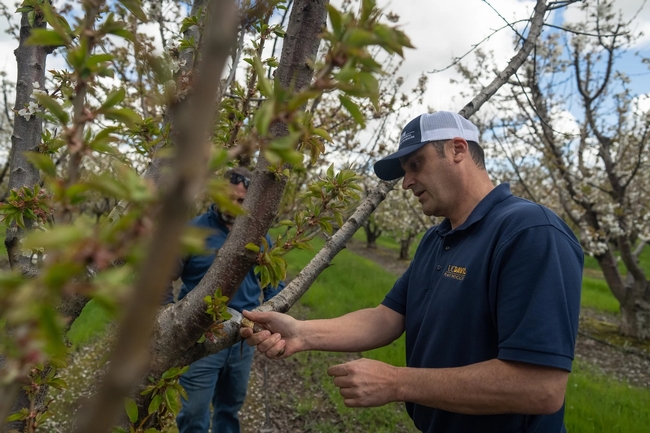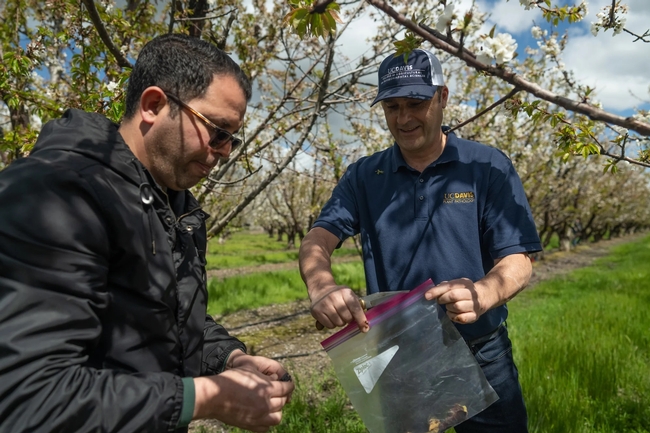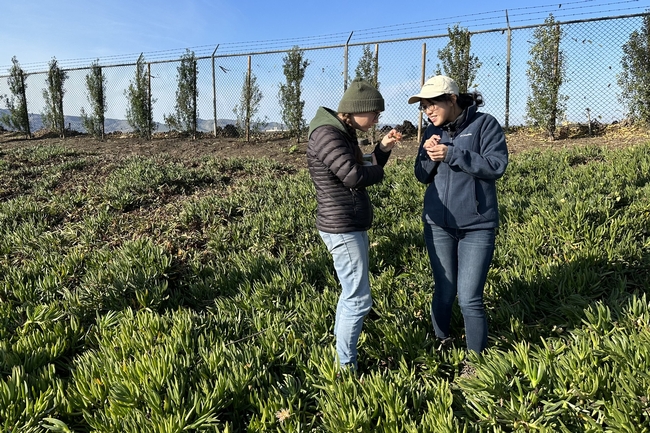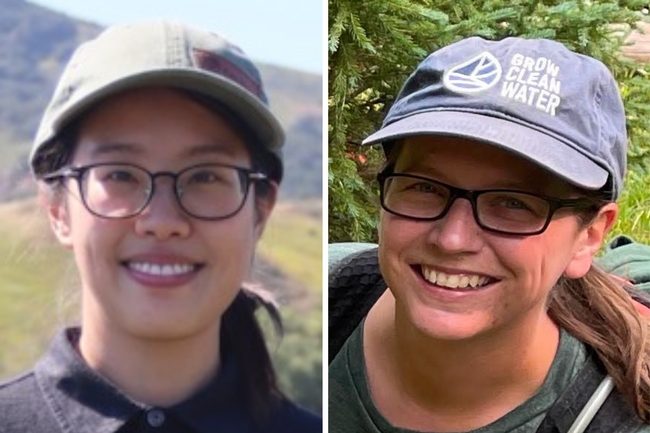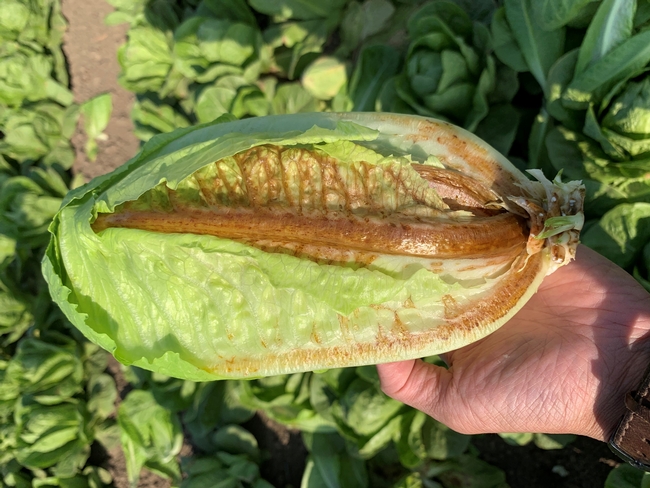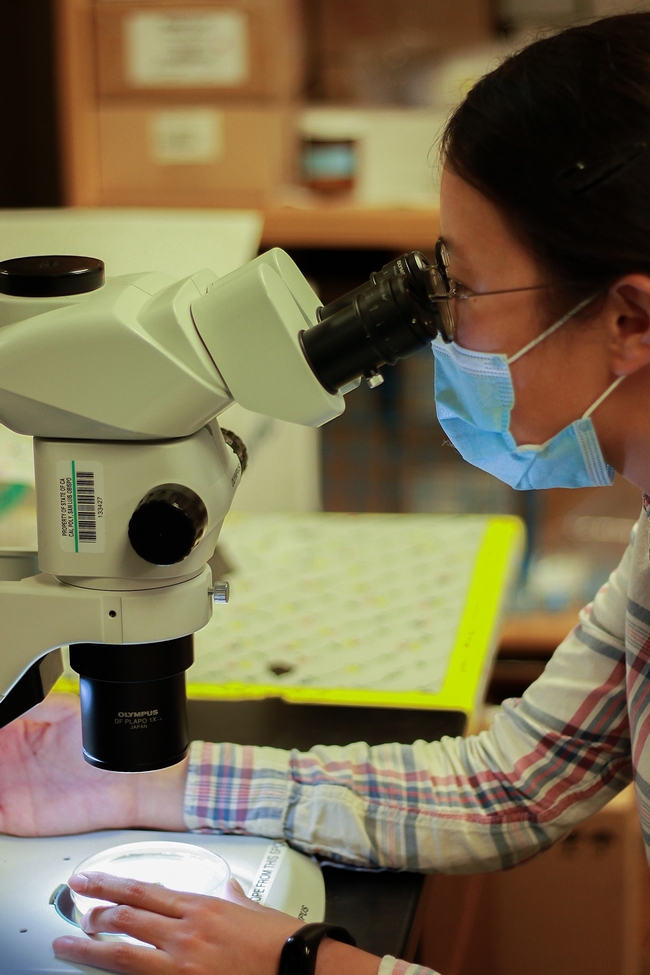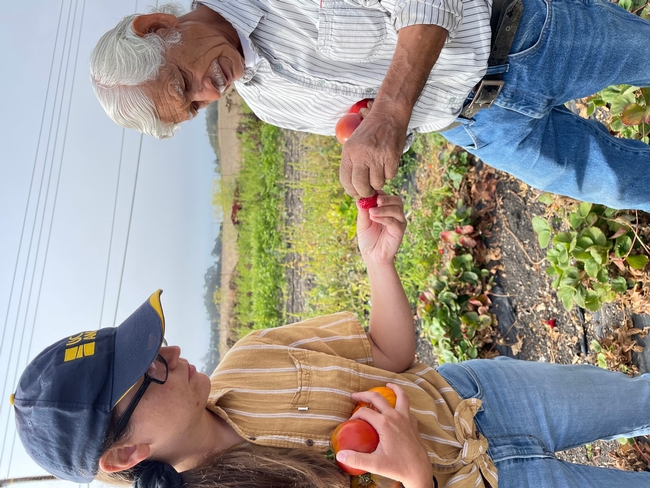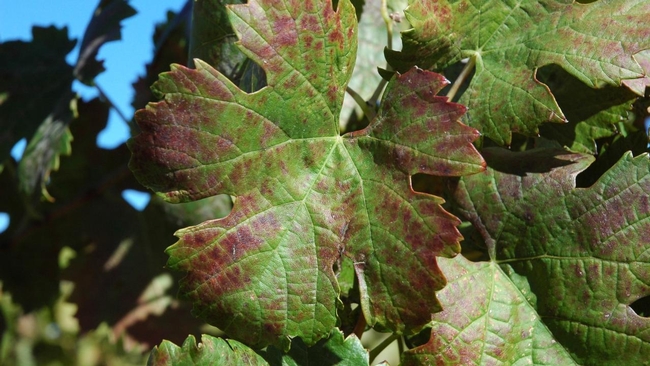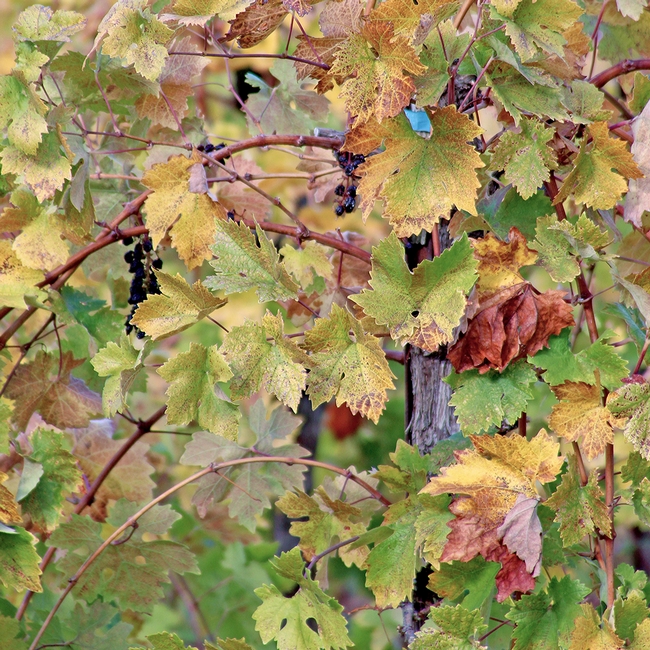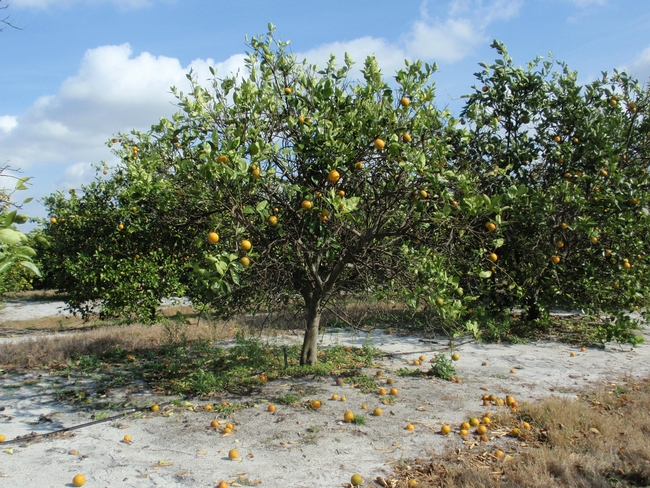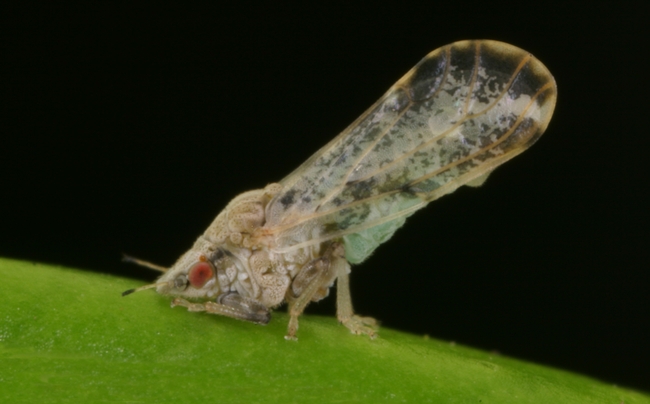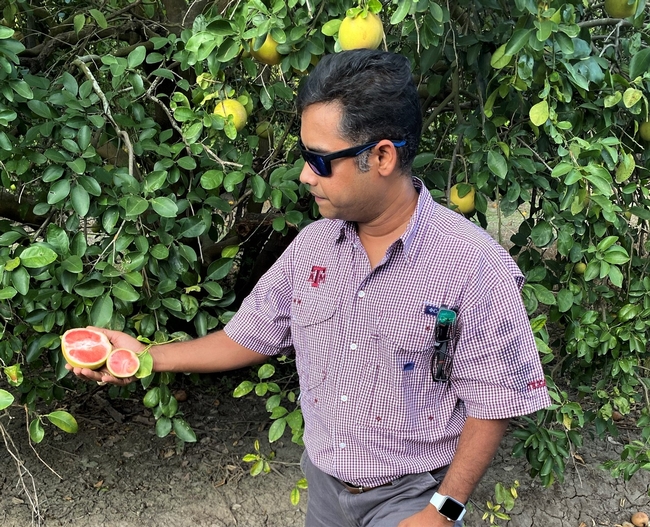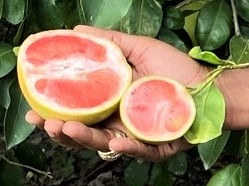Posts Tagged: disease
Winter atmospheric rivers gave pathogens, diseases path to infect crops
Outbreaks similar to El Niño-influenced issues of the 1990s
The wave of atmospheric rivers that swept across the state this winter has created the right conditions for plant pathogens that haven't been seen for decades in California. University of California, Davis, plant pathologist Florent “Flo” Trouillas is getting more calls from growers and farm advisors concerned about potential crop damage.
“Generally, whenever you have rain events, you're going to have problems,” said Trouillas, a Cooperative Extension specialist who is based at the Kearney Agricultural Research and Extension Center in Parlier. “In wet years we get really busy because most pathogens need and like water.”
Trouillas is like a disease detective. He splits his time between the field and the lab, working to diagnose pathogens, diseases and other ailments that strike fruit and nut crops such as almonds, cherries, olives and pistachios.
On a recent visit to an almond orchard near Fresno, Trouillas joined Mae Culumber, a nut crops farm advisor for UC Cooperative Extension Fresno County. A few weeks earlier, the two had walked the orchard, taking note of the base of some trees that had gumming — a thick, jelly-looking substance indicating a pathogen had taken hold.
“A lot of what Florent is doing is trying to assess patterns on a landscape,” Culumber said. “Sometimes things may look like they are one thing, but it could be another problem.”
When the two returned weeks later, the amber-colored gumming had moved into the canopy, looking like gumballs stuck to branches, some of which were already dead. “It's getting out of control from before,” Trouillas says. “This branch was killed. This is widespread.”
From the field to the lab
Lab testing confirmed what Trouillas believed was the culprit: Phytophthora syringae, a pathogen that can affect almond crops but is rarely seen in California. If it is found, generally the site of infection are wounds caused by pruning, but that is not the case here, where the infection began in the canopy at twigs, or small branches.
It is a threat to a key crop, which according to the California Department of Food and Agriculture, generates $5 billion annually. The last time Phytophthora syringae hit California was in the 1990s after a series of El Niño-influenced storms. Trouillas, who has a photographic memory, remembered reading about it in an old manual.
“It's rare for California and one that we see mostly following atmospheric rivers,” he says.
“The disease will only happen following these extremely wet winters.”
Phytophthora is soilborne, mostly found in tree roots, and doesn't generally spread up into branches. But the intense storms created the right conditions for the pathogen to “swim” up trunks as winds blew spores into the air and rain dropped them back down into the canopy, Trouillas said.
Some of the trees in this orchard will die; others can be saved by pruning infected branches and applying a recommended fungicide, he said.
Identification, diagnosis, education
Trouillas is one of more than 50 Cooperative Extension specialists at UC Davis and each is charged with identifying problems and developing solutions for those issues in support of agriculture, the ecosystem and communities throughout the state.
In his role, Trouillas focuses not only on pathology and research but also on educating growers, nursery staff, pest control advisers and others in agriculture about ways to manage potential threats and how to prevent crop damage.
“His role is very crucial,” said Mohammad Yaghmour, an orchard systems advisor for UC Cooperative Extension Kern County. “He's not only on this mission to educate growers but he's also a source of education for us.”
Trouillas typically conducts one or two site visits a week, usually after a farm advisor reaches out about a problem they can't solve on their own.
“This allows us to be at the forefront of disease detections in California,” he said.
He likens these visits to house calls a doctor would make, only to fields instead. And one of those calls recently took him to a cherry orchard in Lodi.
“These guys help me quite a bit,” said Andrew Vignolo, a pest control adviser with Wilbur-Ellis who asked for a consult. “I bug them a lot.”
The visit starts like any consult in a doctor's office, only the questions come fast as they walk around the Lodi orchard where branches are dying, there is gumming and the trees appear stressed. Some look to be sunburned from exposure. Old pruning wounds show cankers, indicating that past disease treatments didn't get rid of whatever was affecting the trees.
Trouillas asks about the cultivar of the trees because some varieties are more susceptible to pests or diseases. He focuses on stress because that opens the door to disease.
Do they prune in the dormant winter months or in summer when pathogens are more prevalent? Does the soil get tested? How old are the trees? What about nutrition?
“I'm trying to figure out how they got infected so bad,” Trouillas said, walking the orchard. “Bacterial canker is a very mysterious disease.”
He thinks it might be a bacterial canker disease and shaves some bark to take to the lab for testing. He wants to come back next winter to take some samples to see where the pathogen is overwintering.
“We'll know in a few weeks if we have a fighting chance,” Vignolo said.
Be it Lodi, Fresno or elsewhere in the state, Trouillas focuses on local conditions. But what is learned in one field can be passed on to others, providing early warnings or advice for those in similar situations. “All these efforts at collaboration, from the field, to the lab, going through research projects, there's only one goal here — to help the farmers of California.”
New UCCE advisors bring fresh ideas to protect lettuce from INSV, Pythium wilt
Salinas Valley lettuce growers lost about $150 million in 2022 due to diseases
A stormy winter could portend another devastating year for the lettuce industry in the Salinas Valley, which saw approximately $150 million in lost gross revenue in 2022 due to INSV (impatiens necrotic spot virus) and associated diseases. Recent drenching rains might mean more weeds – overwintering “reservoirs” for the tiny insect, the Western flower thrips, that carries INSV.
Or the extreme precipitation could benefit growers, as thrips in the soil – during their intermediate stage of development – might be drowned in the waterlogged fields.
As with so many aspects of the INSV crisis, the ultimate effects of flooded fields on thrips populations remain unknown.
“We don't know if thrips are just so persistent and so stable in that pupal stage that maybe they will emerge unaffected,” said Kirsten Pearsons, University of California Cooperative Extension integrated pest management farm advisor for Santa Cruz, Monterey and San Benito counties. “There's just so much about their biology and ecology in the Salinas Valley that we just don't know.”
The mystery of thrips, INSV and soilborne diseases (namely Pythium wilt) is why UC Agriculture and Natural Resources assigned Pearsons to the area last November and hired Yu-Chen Wang in October as UCCE plant pathology advisor for the three counties.
“They're stepping in at a critical moment,” said Richard Smith, the region's UCCE vegetable crop production and weed science advisor who retired in January after a 37-year career. “They've gotten grants funded already – and that's just incredible. They're hitting the ground running.”
Experienced in disease diagnosis and collaboration with growers and industry partners, Wang said her pathology background – paired with Pearsons' entomology expertise – will be crucial in addressing INSV and other diseases.
“It is important for Kirsten and me to work together and provide different insights for the vector and the pathogen, respectively,” Wang said.
‘It's going to take everything to get a crop'
One priority is untangling the dynamics of INSV and Pythium wilt co-occurrence – the subject of ongoing research by JP Dundore-Arias, a plant pathologist at California State University, Monterey Bay. While the vegetables may tolerate one disease or the other, their one-two punch often deals the lethal blow.
“The challenge is – which is why it's great to have Yu-Chen and Kirsten – is that we have so many problems now, whether it's Fusarium (wilt), or Verticillium (wilt), or Pythium, or INSV,” said Mark Mason, pest control adviser for Nature's Reward, which primarily grows lettuces on 5,000 acres across the Salinas Valley.
Mason said that co-infections on his crops (sometimes with three or four diagnosed diseases) make it difficult to assign monetary damages to a specific pathogen, but he noted he has seen fields with “100% loss.” According to the Grower-Shipper Association of Central California, about 11,500 acres were deemed not harvestable in 2022, representing 12% of lettuce industry acreage.
Given the gravity and complexity of the disease dilemma, Pearsons said she has been fielding calls from growers seeking new and better solutions – ways to improve existing tools, techniques borrowed from other crop systems, and additional biological or chemical means of control.
And although there are a couple of pesticides that manage the disease-carrying thrips reasonably well, growers and researchers are worried about their diminishing efficacy due to overuse. Plus, they only constitute a short-term fix.
“Managing the thrips will only reduce the amount of INSV that can get transmitted,” Pearsons explained. “You can kill 99.9% of the thrips, but you get one thrips that has INSV that enters a field, and now you have an infected lettuce plant. All of the thrips are going to come and they can spread it from there; pesticide slows things down, but it's not going to eliminate it.”
Finding disease-tolerant lettuce cultivars is a more sustainable approach. Trials conducted last year by Smith, Wang and others identified several varieties that appeared to hold up well to Pythium and INSV. While additional research could maximize their potential benefit, Wang said even the hardier cultivars will lose their resistance over time, and a multi-layered INSV strategy with “integrated management tools” is crucial.
“We realized, when this thing started happening, that we cannot spray our way out of this problem,” Mason said. “We need varieties; we need management practices; we need pesticides…it just seems like it's going to take everything to get a crop.”
Weeds key to disease control
An all-hands-on-deck approach helped control thrips-harboring weeds last winter. With fields drying out from January storms, Smith said communities must get back to weed management – with a focus on prominent weed hosts for INSV and neglected areas adjacent to farms. Hotspots of infection last year were traced to industrial lots that were overlooked during the weeding process.
“People can't lose sight of the fact that we still need to be controlling the weeds in key areas, because that's the reservoir of the virus during the winter,” Smith said. “We have to stay on task with that.”
Yet despite the diligent weed abatement, crop damage from INSV and Pythium was widespread in 2022, and Smith said it's “very possible” that high heat during the summer was a contributing factor to especially prevalent disease in fall. Thrips populations tend to thrive in warmer weather, Smith said, but much more research needs to be done to understand the basic biology of the insect, including how they acquire the virus and how they spread it.
High hopes for future
Pearsons cited the work of Daniel Hasegawa, a research entomologist with the U.S. Department of Agriculture, who leads teams in monitoring thrips populations in several locations across the Salinas Valley. Currently the counting of thrips on sticky card traps is done manually, but Pearsons and Mason mentioned the possibility of using AI and machine learning to expedite that process.
Mason said that the grower community is excited about the new technologies and ideas that Pearsons and Wang are bringing to the region. As a participant in the search for candidates to fill the advisor positions, Mason said “they were, in my opinion, by far the best fit for what we were looking for.”
“I hope they stay here for 30 years,” he added.
The new advisors both noted the palpable energy and cooperative spirit in the Salinas Valley to proactively meet the challenge.
“Looking to the past, there have been other outbreaks and diseases that they've managed to overcome,” Pearsons said. “These farmers are resilient and creative and I fully believe that lettuce will still be growing here for years to come – it might look a little different, and it might take a little bit of a painful period to get to that point, but I think that we're going to be able to come up with some solutions.”
And while there are concerns that some lettuce growers might decide to leave the region, Wang said she also believes in the industry's strong roots and rich history.
“Salinas Valley has had a beautiful climate for lettuce for so many years; there are some undeniable advantages here,” she said. “This is still the best place in the United States – and maybe the world – to grow lettuce.”
UC Davis to build new $5.25M greenhouse to protect U.S. grapevine collection
Project designed to prevent red blotch and other grapevine diseases
A new, $5.25 million greenhouse is being built on the University of California, Davis, campus to safeguard an important grapevine collection from red blotch disease and other pathogens.
The 14,400-square-foot greenhouse will have a vestibuled entry, be insect-proof and provide another level of disease protection. It is being spearheaded by Foundation Plant Services, or FPS, which provides the U.S. grape industry with high-quality, virus-tested grapevine plant material.
The program serves as the primary source for grapevine plant material distributed to nurseries under the California Department of Agriculture's Grapevine Registration and Certification Program, which provides the majority of grapevines planted in the United States. For the grape industry, it is essential to protect this material from disease-carrying insects and guarantee fast access to clean plant material.
“The program is considered the largest quarantine center for the grapevine industry in the United States,” said Maher Al Rwahnih, a plant pathologist and FPS director. “This is kind of a game changer for us.”
A history of serving the grapevine industry
FPS has maintained healthy grapevine planting stock on the UC Davis campus for more than 70 years in open fields at the Classic and Russell Ranch foundation vineyards. FPS scientists first detected grapevine red blotch virus at Russell Ranch in 2017. By 2021, an estimated 51.6% of the crop there was infected. Material from that vineyard is not being sold, and the site is now part of an epidemiological study to try to pinpoint how the disease is transmitted.
FPS pathologists have detected red blotch on less than 1% of the Classic vineyard crop. But it may not always be that way in the future.
“We don't know how long the Classic vineyard will remain clean,” Al Rwahnih said. “Every testing season, this is what keeps me up at night. We're not sure why it's happening in Russell Ranch and not the Classic vineyard.”
Once the greenhouse is operating, grapevines propagated from plant material from the Classic vineyard will be moved into the greenhouse, tested and verified as clean from disease. From there it will be sold to nurseries, which will grow additional plants to sell to growers.
Two greenhouses part of plan
Normally the foundation has 4,000 vines available, but the greenhouse will only house 2,000 vines, so inventory will be cut in half.
“This phase is just a starting phase,” Al Rwahnih said. “It's not sufficient for our needs.”
FPS plans to build another greenhouse in the next two to three years to increase capacity.
Industry groups and FPS identified greenhouses as the best way to protect the plants from red blotch and other pathogens transmitted by insects. They are also consulting with those same people on the grape varieties to include in the greenhouse.
“We have a large selection, and we need to make sure all the varieties that are important to industry are contained,” he said.
The first greenhouse is expected to be finished by the end of 2023.
Funding for the first greenhouse is coming from a variety of sources. The California Fruit Tree, Nut Tree and Grapevine Improvement Advisory Board, managed by the California Department of Food and Agriculture, contributed $4 million to the project. The California Grape Rootstock Research Foundation gave $500,000, Foundation Plant Services with UC Davis is funding $450,000, and the California Grape Rootstock Commission gave $100,000.
“This is crucial for the grapevine industry, and we are very grateful for the support,” Al Rwahnih said.
Grape experts give workshops on drought preparedness, red blotch
Grape growers and other industry members interested in grape production and water management in vineyards are invited to UC Cooperative Extension's Grapevine Drought Preparedness Workshops.
The workshops will be held in person on Friday, March 4, in San Luis Obispo and Friday, April 1, in Hopland.
Registration is $50 and includes a full day of live instruction from UC Cooperative Extension viticulture and grapevine experts. Lunch will be provided.
For more information and to register, visit https://ucanr.edu/sites/ShortCourse17.
UC Davis Grapevine Red Blotch Disease Symposium
On Wednesday, March 16, UC Cooperative Extension and the UC Davis Department of Viticulture and Enology will host a Grapevine Red Blotch Disease Symposium 9 a.m.-3:30 p.m.
Red blotch disease in grapevines, which can dramatically reduce the value of winegrapes, harms plants by inhibiting photosynthesis in the leaves. Infected vines are unable to conduct water effectively, leaving sugar that is created by photosynthesis stuck in the leaves instead of in the berries.
This event will be presented both in person at the UC Davis Conference Center and livestreamed for those unable to attend in person.
Presentations will cover the role of treehoppers, treatments, mitigation strategies, the impact of the disease on the composition of wine, and more.
Registration is $250 for the in-person symposium at UC Davis and $150 for the livestream. An application for 3.5 CCE units has been submitted to California Department of Pesticide Regulation and is pending approval.
To see the agenda and to register, visit https://wineserver.ucdavis.edu/events/uc-davis-grapevine-red-blotch-disease-symposium.
Citrus threat target of $7 million multistate research project
UC ANR part of team led by Texas A&M AgriLife combating huanglongbing disease
Citrus greening, or huanglongbing disease (HLB), is the most devastating disease for orange and grapefruit trees in the U.S. Prevention and treatment methods have proven elusive, and a definitive cure does not exist.
Since HLB was detected in Florida in 2005, Florida's citrus production has fallen by 80%. Although there have been no HLB positive trees detected in commercial groves in California, more than 2,700 HLB positive trees have been detected on residential properties in the greater Los Angeles region.
“It is likely only a matter of time when the disease will spread to commercial fields, so our strategy in California is to try to eradicate the insect vector of the disease, Asian citrus psyllid,” said Greg Douhan, University of California Cooperative Extension citrus advisor for Tulare, Fresno and Madera counties.
Now, a public-private collaborative effort across Texas, California, Florida and Indiana will draw on prior successes in research and innovation to advance new, environmentally friendly and commercially viable control strategies for huanglongbing.
Led by scientists from Texas A&M AgriLife Research, the team includes three UC Agriculture and Natural Resources experts: Douhan; Sonia Rios, UCCE subtropical horticulture advisor for Riverside and San Diego counties; and Ben Faber, UCCE advisor for Ventura, Santa Barbara and San Luis Obispo counties.
$7 million USDA project
The $7 million, four-year AgriLife Research project is part of an $11 million suite of grants from the U.S. Department of Agriculture National Institute of Food and Agriculture, NIFA, to combat HLB. The coordinated agricultural project is also a NIFA Center of Excellence.
“Through multistate, interdisciplinary collaborations among universities, regulatory affairs consultants, state and federal agencies, and the citrus industry, we will pursue advanced testing and commercialization of promising therapies and extend outcomes to stakeholders,” said lead investigator Kranthi Mandadi, an AgriLife Research scientist at Weslaco and associate professor in the Department of Plant Pathology and Microbiology at the Texas A&M College of Agriculture and Life Sciences.
The UC ANR members of this collaboration will be responsible for sharing findings from the research with local citrus growers across Southern California, the desert region, the coastal region and the San Joaquin Valley.
“In addition to the ground-breaking research that will be taking place, this project will also help us continue to generate awareness and outreach and share the advancements taking place in the research that is currently being done to help protect California's citrus industry,” said Rios, the project's lead principal investigator in California.
Other institutions on the team include Texas A&M University-Kingsville Citrus Center, University of Florida, Southern Gardens Citrus, Purdue University and USDA Agricultural Research Service.
“This collaboration is an inspiring example of how research, industry, extension and outreach can create solutions that benefit everyone,” said Patrick J. Stover, vice chancellor of Texas A&M AgriLife, dean of the Texas A&M College of Agriculture and Life Sciences and director of Texas A&M AgriLife Research.
HLB solutions must overcome known challenges
An effective HLB treatment must avoid numerous pitfalls, Mandadi explained.
One major problem is getting a treatment to the infected inner parts of the tree. The disease-causing bacteria only infect a network of cells called the phloem, which distributes nutrients throughout a tree. Starved of nutrients, infected trees bear low-quality fruits and have shortened lifespans.
Treatments must reach the phloem to kill the bacteria. So, spraying treatments on leaves has little chance of success because citrus leaves' waxy coating usually prevents the treatments from penetrating.
Second, while the bacteria thrive in phloem, they do not grow in a petri dish. Until recently, scientists wishing to test treatments could only do so in living trees, in a slow and laborious process.
Third, orange and grapefruit trees are quite susceptible to the disease-causing bacteria and do not build immunity on their own. Strict quarantines are in place. Treatments must be tested in groves that are already infected.
Two types of potential HLB therapies will be tested using novel technologies
The teams will be working to advance two main types of treatment, employing technologies they've developed in the past to overcome the problems mentioned above.
First, a few years ago, Mandadi and his colleagues discovered a way to propagate the HLB-causing bacteria in the lab. This method involves growing the bacteria in tiny, root-like structures developed from infected trees. The team will use this so-called “hairy roots” method to screen treatments much faster than would be possible in citrus trees.
“Even though a particular peptide may have efficacy in the lab, we won't know if it will be expressed in sufficient levels in a tree and for enough time to kill the bacteria,” Mandadi said. “Viruses are smart, and sometimes they throw the peptide out. Field trials are crucial.”
The second type of treatment to undergo testing is synthetic or naturally occurring small molecules that may kill HLB-causing bacteria. Again, Mandadi's team will screen the molecules in hairy roots. A multistate team will further test the efficacy of the most promising molecules by injecting them into trunks of infected trees in the field.
A feasible HLB treatment is effective and profitable
Another hurdle to overcome is ensuring that growers and consumers accept the products the team develops.
“We have to convince producers that the use of therapies is profitable and consumers that the fruit from treated trees would be safe to eat,” Mandadi said.
Therefore, a multistate economics and marketing team will conduct studies to determine the extent of economic benefits to citrus growers. In addition, a multistate extension and outreach team will use diverse outlets to disseminate project information to stakeholders. This team will also survey growers to gauge how likely they are to try the treatments.
“The research team will be informed by those surveys,” Mandadi said. “We will also engage a project advisory board of representatives from academia, universities, state and federal agencies, industry, and growers. While we are doing the science, the advisory board will provide guidance on both the technical and practical aspects of the project.”
Project team members:
—Kranthi Mandadi, Texas A&M AgriLife Research.
—Mike Irey, Southern Gardens Citrus, Florida.
—Choaa El-Mohtar, University of Florida Institute of Food and Agricultural Sciences, Citrus Research and Education Center.
—Ray Yokomi, USDA-Agricultural Research Service, Parlier, California.
—Ute Albrecht, University of Florida IFAS Southwest Florida Research and Education Center.
—Veronica Ancona, Texas A&M University-Kingsville Citrus Center.
—Freddy Ibanez-Carrasco, Texas A&M AgriLife Research, Department of Entomology, Weslaco.
—Sonia Irigoyen, AgriLife Research, Texas A&M AgriLife Research and Extension Center at Weslaco.
—Ariel Singerman, University of Florida IFAS Citrus Research and Education Center.
—Jinha Jung, Purdue University, Indiana.
—Juan Enciso, Texas A&M AgriLife Research, Department of Biological and Agricultural Engineering, Weslaco.
—Samuel Zapata, Texas A&M AgriLife Extension, Department of Agricultural Economics, Weslaco.
—Olufemi Alabi, Texas A&M AgriLife Extension, Department of Plant Pathology and Microbiology, Weslaco.
—Sonia Rios, University of California Cooperative Extension, Riverside and San Diego counties.
—Ben Faber, University of California Cooperative Extension, Ventura, Santa Barbara and San Luis Obispo counties.
—Greg Douhan, University of California Cooperative Extension, Tulare, Fresno and Madera counties.


